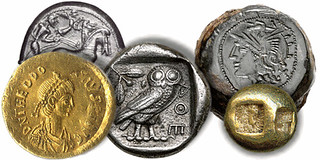
PREV ARTICLE
NEXT ARTICLE
FULL ISSUE
PREV FULL ISSUE
ANCIENT COUNTERFEITERS AND THEIR COINS
I almost missed this great CoinWeek article by Mike Markowitz on ancient counterfeiters. It was published February 1, 2016.
Here's an excerpt - be sure to read the complete version online. -Editor
There were two basic ways of counterfeiting ancient coins. The first was to cover a base metal core with a thin layer of precious metal and then strike it between engraved dies. If the coating was seamless, the dies of good quality, and the weight of the finished piece close enough to the official standard, such coins might pass as genuine. They are known as fourées, from a French word meaning “stuffed.” The second way was to make clay molds from an original coin, and then pour molten metal into the molds, usually leaded copper alloy. Ceramic molds could be mass-produced cheaply, so low-value copper coins could be counterfeited profitably. There was a chronic shortage of small change in ancient economies, so even poor quality fakes were accepted in markets for lack of anything better. Authorities tended to ignore such forgeries, even when they enforced savage penalties against counterfeiting precious metal coins. The “owl” tetradrachms of Athens enjoyed a reputation as good silver and circulated widely in the ancient world. Imitations were so common that in 375 BCE the city enacted “Nikophon’s Law”, establishing official coin testers in the agora (public market): The Tester would carefully inspect suspected coins, weigh them against the official standard (an “Attic” or Athenian tetradrachm was supposed to weigh 17.24 grams), and perhaps make test cuts on the edge with a small chisel to see if there was a plated core. Many surviving owls bear such test cuts, which greatly reduce their value to collectors. Some counterfeit owls, even with noticeably deficient weight, managed to survive intact and be collectable today — a 12.44 gram example sold for $300 in a recent auction. 
A handful of ancient counterfeiters’ dies used to strike denarii have survived to command high prices on the antiquities market; the example illustrated went for $4,000 in a 2014 auction[9]. There are even fake ancient counterfeiter’s dies (used to strike modern fakes of ancient Roman coins – a topic we will explore in a future article). To read the complete article, see:
Wayne Homren, Editor The Numismatic Bibliomania Society is a non-profit organization promoting numismatic literature. See our web site at coinbooks.org. To submit items for publication in The E-Sylum, write to the Editor at this address: whomren@gmail.com To subscribe go to: https://my.binhost.com/lists/listinfo/esylum All Rights Reserved. NBS Home Page Contact the NBS webmaster 
|
